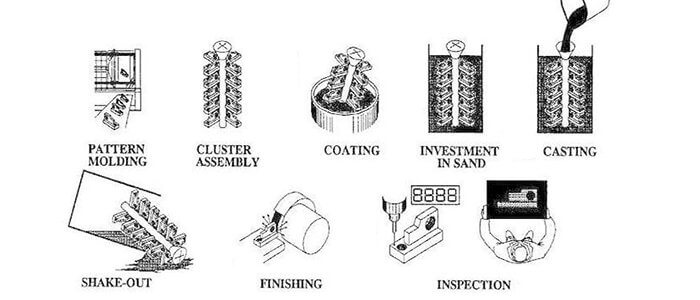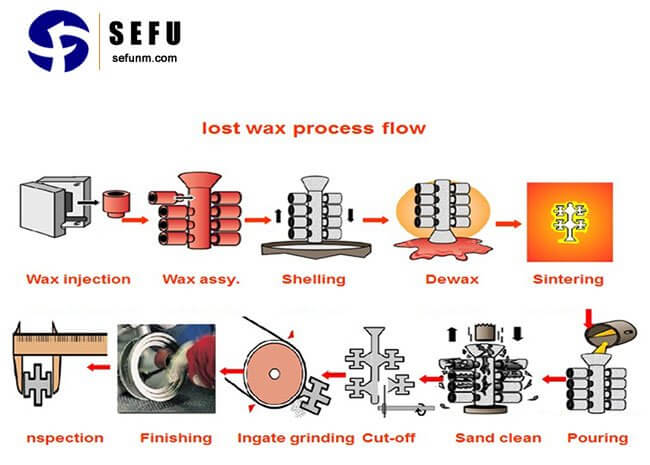Casting is the process of creating objects, usually metallic ones, by pouring molten metal into a mould, which takes a desired shape. There are various methods of casting, one of which is lost foam casting and investment casting. Both methods have a significant role in modern manufacturing processes with different applications. Investment casting is an ancient method of producing metallic objects, while lost foam casting is a relatively new process that is gaining popularity in today’s production industries.
This article will explore the difference between lost foam casting and investment casting, their advantages and disadvantages, as well as the use of ceramic foam filters in these processes.
What is Lost Foam Casting?
Lost foam casting (LFC) is a type of investment casting that uses polystyrene foam patterns instead of wax patterns. This process is sometimes referred to as evaporative castings, foam castings or full mold casting. It involves creating a pattern that represents the desired shape of the final product. The foam pattern is then coated with a refractory material, creating a mould that will be filled with molten metal.

The molten metal is poured into the mould, causing the foam pattern to evaporate, leaving a void. The metal fills the void and takes the shape of the original pattern. The final product is obtained by breaking off the refractory mould, which leaves the cast metal part.
Lost foam casting is a fast and efficient way of producing complex metallic parts with low tolerances and a good surface finish. Due to its simplicity, lost foam casting is suitable for small-scale production and is widely used in the automotive, aerospace, and industrial sectors.
What is Investment Casting?
Investment casting (IC) is a manufacturing process that has been used for thousands of years. It involves creating a pattern or wax mould of the final product, which is then coated in a ceramic shell material. The ceramic shell is created by repeatedly dipping the wax mould into a ceramic slurry and then allowing it to dry. The process is repeated several times until the ceramic shell has reached the desired thickness.
After the shell has hardened, the wax is melted out of the mould, creating a hollow cavity in the ceramic shell. The cavity is then filled with molten metal, which takes the shape of the original pattern. Once the metal has cooled and solidified, the ceramic shell is broken away, leaving the final product.

Investment casting is a precise and flexible casting method capable of producing complex shapes and tight tolerances. It is commonly used in the aerospace, automotive, and engineering industries, where the quality of the final product is critical.
Difference between Lost Foam Casting and Investment Casting
Lost foam casting and investment casting may appear similar, but they differ significantly in many aspects, such as:
Materials used – Lost foam casting uses polystyrene foam as a patterned material, while investment casting uses wax or plastic patterns.
Process – In lost foam casting, the pattern is evaporated while investment casting melts the pattern out.
Product quality – Investment castings can provide a superior surface finish and higher dimensional accuracy than lost foam castings.
Size of the product – Lost foam casting is suitable for small and medium-sized products with simple shapes, while investment casting is ideal for larger and complex products.
Production speed – Lost foam casting has a shorter production time than investment casting, but investment casting is capable of producing more significant quantities.
Cost – Lost foam casting is usually cheaper than investment casting and requires less equipment.
Advantages and Disadvantages of Lost Foam Casting and Investment Casting
Lost foam casting and investment casting have advantages and disadvantages, which depend on the application and production requirements; these are:
Advantages of Lost Foam Casting:
– Capable of producing complex shapes and thin-walled products.
– High dimensional accuracy.
– Smooth surface finish.
– No parting lines on the final product.
– Shorter production time than investment casting.
– Capable of low to medium production runs.
– Low tooling cost makes it economical for prototypes and small batch production runs.
– Foam patterns are recyclable.
Disadvantages of Lost Foam Casting:
– Limited to small and medium-sized parts with simple shapes.
– Limited to non-ferrous metals such as aluminum, copper, and brass.
– The refractory coating can be punctured if not handled correctly.
– Produces toxic fumes during the casting process.
– Foam patterns are brittle and can be difficult to handle.
Advantages of Investment Casting:
– High level of dimensional accuracy.
– Superior surface finish.
– Able to create complex, intricate, and thin-walled products.
– Suitable for small to medium production runs.
– Produces parts with tight tolerances.
– Capable of casting a wide range of alloys, including precious metals.
Disadvantages of Investment Casting:
– Longer production time than lost foam casting.
– Higher tooling costs than lost foam casting.
– Higher costs for initial orders and design changes.
– Limited product size.
– Wasteful, with a considerable amount of materials being lost during the process.
Ceramic Foam Filters in Casting
As casting processes become more popular and precise, achieving the desired quality level has become more challenging. The introduction of ceramic foam filters has opened up new possibilities in casting applications. Ceramic foam filters are made of either zirconia or alumina coated with a silica or metal oxide layer. These filters are used in casting to remove impurities such as slag, sand, and dross from the melt.
Ceramic foam filters have many benefits, including:
– Improving the surface finish and integrity of the final product.
– Reducing internal defects such as porosity and cracks.
– Maintaining a consistent temperature.
– Increasing productivity by reducing scrap rates.
– Reducing the overall cost of production.
Ceramic foam filters are used in both investment casting and lost foam casting methods to produce high-quality products. The use of ceramic foam filters can not only improve product quality but also reduce costs associated with the maintenance of equipment, waste disposal, and electricity consumption.
Conclusion
In conclusion, lost foam casting and investment casting are two distinct casting methods. Lost foam casting is more suitable for small to medium-sized products with simple shapes, while investment casting is ideal for larger and complex products with superior surface quality and dimensional accuracy. While both have advantages and disadvantages, ceramic foam filters have revolutionized casting processes globally. The use of ceramic foam filters is highly beneficial in improving final product quality, internal defects, and overall production costs. Therefore, considering the application, complexity, and size of the product, one should choose either lost foam casting or investment casting. However, the use of ceramic foam filters should be standardized globally to enhance product quality as well as reduce production costs.

